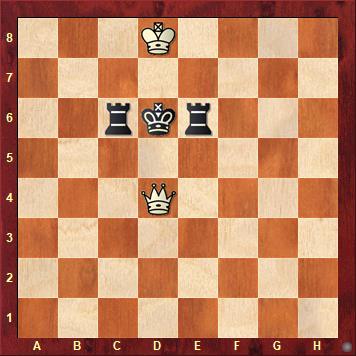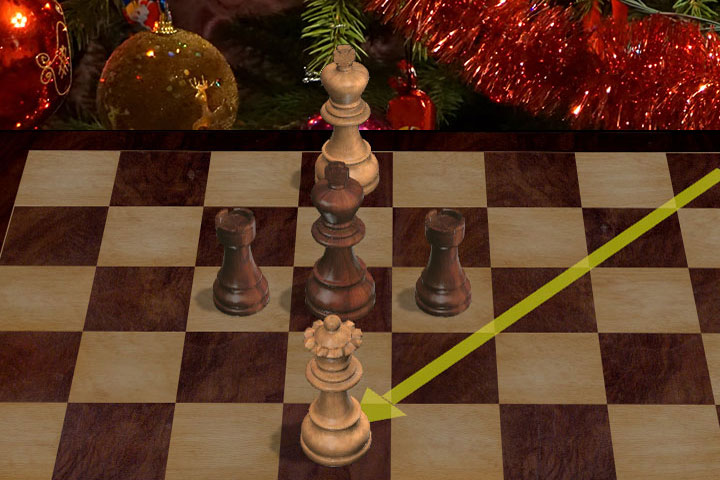
Loyal ChessBase readers will remember how we used to greet our readers, on Christmas day, with ICQ cards. These were animated Flash greeting cards, and you can watch "Santa's time machine" above by clicking here (may no longer run automatically in some browsers).
Chess is all about mate. You must admit that the ultimate goal of the game should receive its share of attention. The only problem is that mates never actually occur. Virtually never. Sometimes at an open or in a blitz game a grandmaster will actually deliver mate; and many have done so in their early pre-teen tournaments. But even when they mate it is usually a very mundane affair, with a protected queen slamming itself onto a square next to the enemy king, or one of those perennial backrank affairs. This is natural, because each side is trying to prevent the other from executing a brilliant checkmate.
All this is a real shame, because the game of chess contains a vast treasure-trove of extraordinarily beautiful mating motifs. There are thousands and thousands of checkmate positions which we normal human beings playing in regular chess tournaments will never see.
One reaction to this unfortunate situation was the chess problem, which appeared almost together with the advent of chess. Here an artificial situation is constructed where one side can deliver a very difficult (actually hard-to-see) mate in a specific number of moves. "Mate problems" have been around since the invention of chess. They can probably show us an additional few percent of the checkmates that exist with the 32 pieces of a chess set.
 In 1860 one of the greatest composers of chess problems, Samuel Loyd, had an idea. He describes it in the book shown at the left, one of my great problem chess treasures. It is a Dover book from 1962, originally published by Whitehead and Miller in 1913. It was given to me by a friend from Finland, Mika Korhonen, back in 1987, when he saw how attached I had grown to it during a stay in his appartment in Helsinki.
In 1860 one of the greatest composers of chess problems, Samuel Loyd, had an idea. He describes it in the book shown at the left, one of my great problem chess treasures. It is a Dover book from 1962, originally published by Whitehead and Miller in 1913. It was given to me by a friend from Finland, Mika Korhonen, back in 1987, when he saw how attached I had grown to it during a stay in his appartment in Helsinki.
Problem number 25 in the book introduces the concept of a "help-mate". In his annotation Loyd is quoted as saying: "The most suggestive field for a new school of problems that has ever occurred to me, and one which would open up a new line of wonderfully intricate combinations, is shown in number 25, where the query is is merely: How could it possibly happen that White effected a mate in three moves? This it will be observed necessiates an active participation on the part of the Black forces, for both parties enter into a friendly alliance to effect the mate."
It was the first full-fledged genuine helpmate ever published, and it introduced a new era into chess problem composition which has resulted in tens of thousands of exceptionally beautiful and fascinating problems. After the direct mate the helpmate is the second most popular type of chess problem.
The solution to this problem is given below, but before you peek you may want to try to find it yourself. For newbies: Black plays the first move, both sides work together and cooperate to construct a position in which the black king is mated. They have three moves (by each side) to do this. Move the pieces on the board to construct the mate.
The above problem was originally published with a black bishop on h2. This is superfluous and was the remnant of earlier attempts some months before to construct the problem with a different checkmate position. In fact the earliest version had two black bishops on g2 and h2, and Loyd had written a story around the problem entitled "The Sin of the Nuns" (i.e. the two black bishops). But after discovering a much nicer solution the "cook" became the main problem.
So let us solve this historical first helpmate ever composed. It would seem quite impossible to find a way in which the rook and bishop can mate, even with the cooperation of Black. Remember all the moves must be legal. The main problem is the black queen, which is such a powerful defensive piece. In fact the solution requires a double-check in which the queen cannot cover both lines of attack. So Black starts with 1.Kf6 (in helpmates the black move is written like white moves in normal chess) 2.Ra8! Kg7 3.Bb8! (allowing the black king access to the corner square) Kh8 4.Be5#.
After my visit to Helsinki and multiple visits by Mika to my home in Germany I became enamored with helpmates. I solved countless problems in this category, and was egged on by John Nunn, who is also a virtuose helpmate composer. At some stage I decided to try composing a helpmate myself. I will describe the process here.
The idea I had was to find a helpmate that resulted in the following pretty mating position, a variation of the famous "epaulette mate".

My first attempt was the following starting position
You can follow the intended solution by entering the following moves on the above diagram: 1.Rc5 h5 2.Re6 h6 3.Rcc6 h7 4.Kc5 h8=Q 5.Kd6 Qd4#. Bingo, we have my envisioned mate! I was really pleased and contemplated submitting the problem for publication. But you have to look at the position carefully before you do this. Chess engines were of no use in checking, so I had to do this manually, using Brain 2.0 (which I keep installed in my head) to look for cooks. It took some hours, but this is what I found:

[Event "Composition"] [Site "?"] [Date "2002.02.??"] [Round "?"] [White "Friedel, Frederic"] [Black "h#5"] [Result "*"] [Annotator "Friedel,Frederic"] [SetUp "1"] [FEN "3K4/8/7r/7r/1k5P/8/8/8 b - - 0 1"] [PlyCount "10"] [EventDate "2002.??.??"] 1... Rc5 {0} (1... Ra5 2. h5 Rha6 3. h6 Ra2 4. h7 R6a4 (4... Ka3 {A fatal alternative move sequence (transposition)} 5. h8=Q Ra4 6. Qc3#) 5. h8=Q Ka3 6. Qc3# {[#]A different motif, the famous "epaulette mate".}) (1... Re5 2. h5 Rc6 3. h6 Kc5 (3... Ree6 {Another fatal transposition, which are never allowed in helpmates.} 4. h7 Kc5 5. h8=Q Kd6 6. Qd4# {just as in the main composition, with the same final mating position.}) 4. h7 Kd6 5. h8=Q Re6 6. Qd4# {[#] Another variation that spoils the composition.}) (1... Rb5 2. h5 Rhb6 3. h6 Ka3 4. h7 Rb3 5. h8=Q R6b4 6. Qa1# {[#]This final position is also an interesting mating position.}) 2. h5 Re6 3. h6 Rcc6 4. h7 Kc5 5. h8=Q Kd6 6. Qd4# *
If you play through the alternate lines you will see how they spoil the composition. Helpmate problems are very strict about purity: there must be no deviations – a single unique line of play must solve the problem.
So I got back to work looking for a version that was sound. I don't recall how long it took, but I finally came up with the following position:
The solution: 1.Rc5 h5 2.Re6 h6 3.Kc6 h7 4.Kd6 h8=Q 5.Rc6 Qd4#. This helpmate is valid and valuable because: 1. it produces a pleasing and unsual mating position; and 2. because there is only one unique set of moves that fulfils the condition and leads to mate in the required number of moves. There is not a single deviation that is possible, no change in move order, no transposition. That is what is required of a proper helpmate. You can enter moves on the above diagram and try to find alternatives ("cooks"). I am sure you will not be successful.
So why don't you try doing this yourself? (I speak here to amateurs, not to professional problem composers who churn these things out before breakfast). Look for an attractive mate, one you will never encounter in regular games. Then look for a position where a series of unlikely and hard to find move will lead to the mate – and then make sure there are no alternate lines to spoil the problem. You cannot imagine how satisfying it is to come up with a sound helpmate.
For the best helpmate by an amateur reader we have two special signed programs as a prizes. Submissions must be accompanied by a statement assuring us you have never published a helpmate before. Use "feedback to the editors" below to send us your compositions.



















 In 1860 one of the greatest composers of chess problems, Samuel Loyd, had an idea. He describes it in the book shown at the left, one of my great problem chess treasures. It is a Dover book from 1962, originally published by Whitehead and Miller in 1913. It was given to me by a friend from Finland, Mika Korhonen, back in 1987, when he saw how attached I had grown to it during a stay in his appartment in Helsinki.
In 1860 one of the greatest composers of chess problems, Samuel Loyd, had an idea. He describes it in the book shown at the left, one of my great problem chess treasures. It is a Dover book from 1962, originally published by Whitehead and Miller in 1913. It was given to me by a friend from Finland, Mika Korhonen, back in 1987, when he saw how attached I had grown to it during a stay in his appartment in Helsinki.






